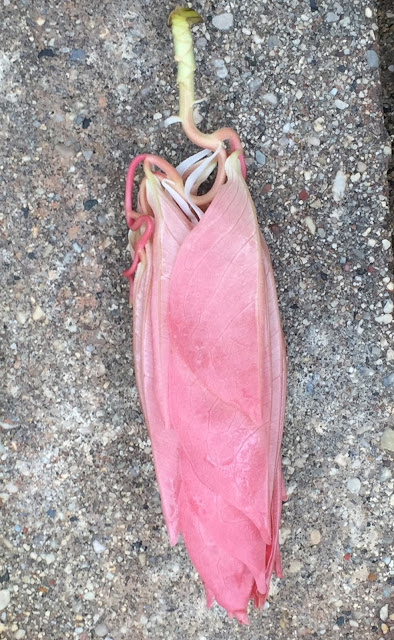Spring seems to have arrived and since the spring showers (actually a downpour) is currently curtailing TPP's field and garden work, blogging seems like the right thing to do. Even in the glasshouse a number of plants respond to the return of longer days. And this includes one of TPP's favorites, the silk handkerchief tree, Maniltoa lenticellata (Fabaceae: Caesalpinioideae) a native of Queensland, Australia. TPP has featured this tree before (here and here), but that was some years ago now (OMG, TPP has been blogging for nearly a decade!). But this spring's tree flush was pretty spectacular, so spectacular that even plant diversity students noticed!
At any rate the amazing displays of new foliage are pink, very pink, and a whole leafy branch drops out of a bud all at once (this one if about 18" long). A student pointing to a bud asks, "How does all of that fit in there?" TPP responds, "Ah, good, curiosity." And he picks off a bud, a really big bud, and says, "Take it apart and find out." Clearly, judging by her reaction, that was an unexpected event. However this is a quite instructional activity so why not share it with readers? Since the tree flushes more or less all at once it can be quite a decorative display.
The buds do get quite large, some 5-6" long before they open, so the flush never comes as a surprise, unless the buds contain flowers (see 2nd link above). Actually the students quite accurately observed that the overlapping bud scales make the bud look a bit like a shrimp. Removing the bud scales is fairly easy, but sorting out the interior is a bit of a challenge.
The leaflets are folded in half upper side in and each leaf usually consists of 8 leaflets in 4 pairs. Each leaf also has a pair of long, thin, pale, and early dehiscent stipules at its base. The leaf rachis and stem are sort of looped into S-shapes to shorten them. So here's the bud with the scales removed. You can see the scale scars on the greenish stem at the top.
Now you have to rather carefully tease the whole thing apart. This bud contains 5 leaves and the length of twig to which they are attached. Here it is in the same relative orientation.
Starting at the top, the upper most leaf if to your right; the rachis is a bit pinker than the twig and you can see the long, white stipules at its base. Then the 2nd leaf is to the left, then follow the twig along a big C-shaped curve to get to the 3d leaf (to the right again), then back to the left for the 4th leaf and lastly more or less in the middle, and smallest, if the 5th leaf. Isn't that grand?
These long pink flushes gradually fade into a pale green as the chlorophyll develops. Eventually the twig and leaves lift themselves up into a graceful arching branch. The function of such pink flushing and the limp branches has been debated. TPP remains uncertain.
Change of address
5 months ago in Variety of Life




















No comments:
Post a Comment